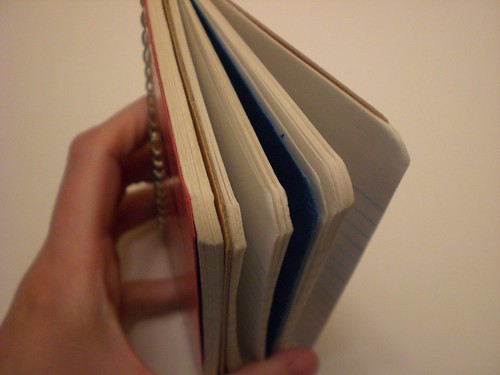A commenter named Thao had this question in response to my post about hoarding notebooks for the future:
“My question for you is how do you repurpose a notebook after its initial use fizzles out? Like projects that never finish or die out and you’ve already devoted 10% of the pages to it. Do you tear those pages out? Do you cover them over? Or can you calmly ignore those pages and continue using the rest of the notebook for a new purpose?”
Great question! I’ve had many notebooks over the years which started out being dedicated to some specific project but then quickly fizzled out. I have sometimes torn out the pages. I have sometimes taped them together so it was easy to flip past and ignore them. If I had written a subject on the front, I just stuck a sticker or label over it. When I was a kid I also repurposed some spiral notebooks by twisting the wires out and then combining some of the pages together and twisting the spiral back in, sometimes even reusing the extra covers to make section dividers.
But in other cases, the notebook was just abandoned and sits in one of my many boxes in a still uncompleted state…
How about you, readers?


Sometimes I’ve taken to repurposing really old notebooks I or my siblings have left over from our school days. Once I used one of my brother’s notebooks from fourth grade, with the school logo still embossed on the front. I tore out the used pages but otherwise left it as is; I like the idea of a notebook with a history taking on a second life once it has a new owner (with permission, of course!)
I think of regular spirals as transient, a place for things that are either going some other place (written in better handwriting), or simply going in the recycling bin at some point.
My problem on this point is with bound books. I have real trouble writing in them because I’m afraid of not filling them up. I’ve had notebooks fizzle in these before, and I feel its such a waste of a pretty book. I even have trouble writing in the prettier composition books because of this.
One of the best ways I have found is to leave the first four or so pages n the front of any notebook as an Index. I keep the pages numbered and write down page numbers and the topics, records, etc. on that page in my index. The project name or purpose of the notebook is at the top of the index. For example: GARDENING IDEAS.
Then, if I don’t use all the pages, I just write a new project name in big bold letters and keep right on rolling in the same notebook.
Later, you can even put the various themes, projects, etc. on the cover of the notebook using a label maker that way you know al the various projects contained in it.
If you go into a new notebook with the understanding that it may be used for multiple purposes, it makes it a lot easier.
I like to carry a pocket notebook for notes on the go and keep another notebook at home for journaling, but I start to write a lot in the pocket one and it becomes my journal. So the actual journal gets abandoned, it’s terrible but most of the time I end up tearing out the pages and throwing the notebook away with recycling (because it makes me uncomfortable having those private thoughts left behind in a notebook I don’t revisit).
I like your pagination method, Joe. I’ve started using Leuchtturm pocket notebooks and they’re great because they have numbered pages and light ruling.
I think this is why I don’t tend to devote a notebook to a single project, but rather a more general purpose, like “work” or “sketches” or “writing ideas.” The few times I’ve tried to get ambitious and devote an actual, single project to one notebook, it hasn’t worked out. In school though, if class ended and the notebook wasn’t finished, I used to just write the new subject underneath the old one on the cover, devote the next blank page to something like, “CALCULUS FALL *insert semester*” or whatever, and continue where I left off.
‘Re-starting’ a partly used notebook for a different purpose does seem to be difficult, it’s a strange thing! In theory many types of notebook can be taken apart and all or in part re-bound in new covers. The content would need to be important though due to the labour cost. We offer our Stamford Notebook customers a service on our own traditionally made notebooks whereby we can reconstruct a whole damaged notebook and re-bind (depending on damage) or add more new pages or bind the contents of two notebooks into one. It may be possible with other brands. We also do this with printed books but leave antiquarian and rare book restoration to the few one-off specialists. If you do have a particular requirement then please track us down.
I recently took a half-filled sketchbook I hadn’t worked in since 1999 and started it up again. First, I lived with it for a few weeks, just looking through what was there, appreciating the paper and the scent of the book. I took out and/or glued together a couple of pages I didn’t like. Finally, the day came when I needed a book to use at an urban sketching group outing. This book is a medium size, spiral bound so it can be folded back and will lie flat. The paper is wonderful. And there was no risk since the book was already used. I kept drawing in it after that and filled it up in a couple of months. So glad I got re-acquainted with this old friend.